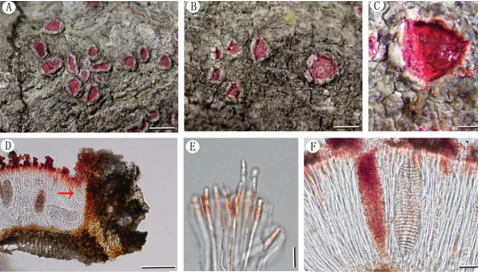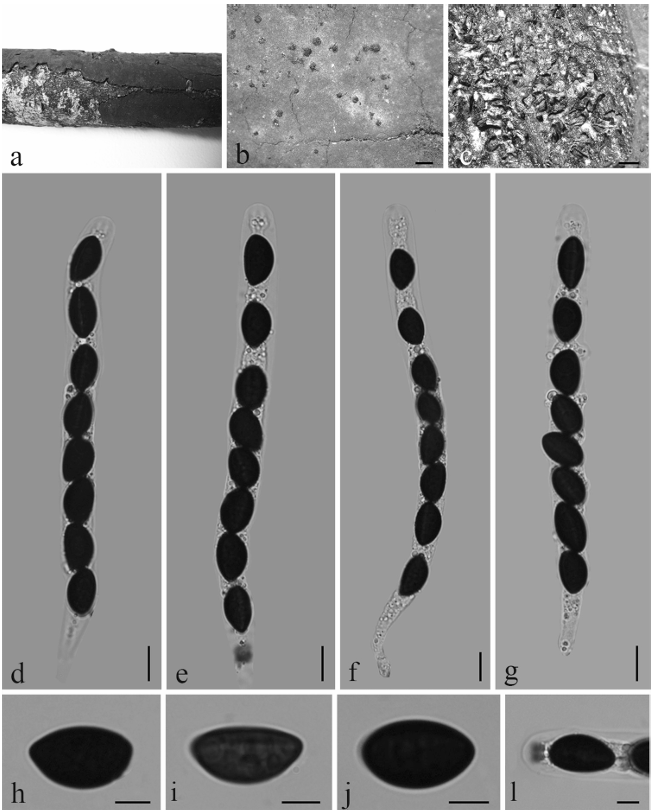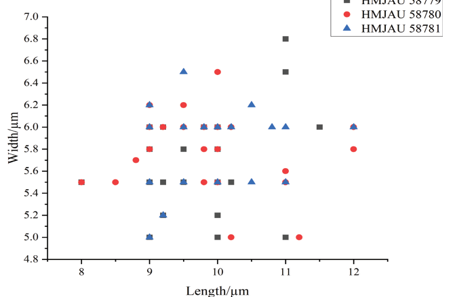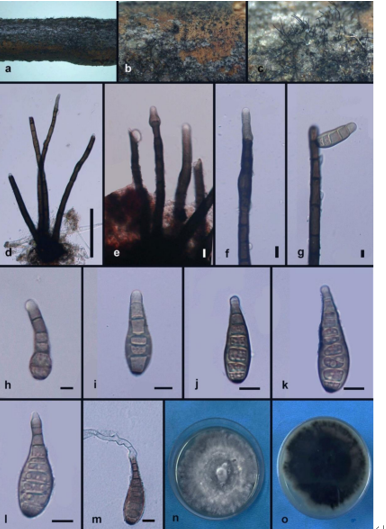Megasporoporiella hubeiensis Y.C. Dai & Yuan Yuan, comb. nov. 2021
MycoBank Index Fungorum number: IF558815; Facesoffungi number: FoF10468
Holotype: Dai 18102.
Morphological description
Sexual morph:Basidiocarps biennial, resupinate, cushion-shaped, corky, without odor or taste when fresh, becoming hard corky upon drying, up to 2.4 cm long, 12 cm wide, and 2.4 mm thick at center; sterile margin thinning out, very narrow to almost lacking. Pore surface white to cream when fresh, vinaceous buff to fulvous when dry; pores round to angular, 1–2 per mm; dissepiments thick, entire; subiculum pale buff, corky, up to 0.6 mm thick; tubes concolorous with the pore surface, corky, up to 1.8 mm long. Hyphal system dimitic; generative hyphae bearing clamp connections; skeletal hyphae IKI–, CB+; tissues unchanged in KOH. (not dissolved). Subicular generative hyphae hyaline, thin-walled, occasionally branched, 2.5–2.8 µm in diam; skeletal hyphae dominant, thick-walled with a narrow to medium lumen, frequently branched, mostly flexuous, interwoven, 2.8–3 µm in diam. Tramal generative hyphae hyaline, thin-walled, occasionally branched, 1.8–2.5 µm in diam; skeletal hyphae dominant, thick-walled with a narrow lumen, frequently branched, mostly flexuous, interwoven, 2.5–3 µm in diam. Dendrohyphidia present. Hyphal pegs absent. Cystidia absent; cystidioles present, subulate or ventricose, thin-walled, smooth, 18.2–37.2 × 6.3–10.5 µm. Basidia clavate, with four sterigmata and a basal clamp connection, 26.8–34.2 × 7.8–11.2 µm; basidioles in shape similar to basidia, but smaller. Small tetrahedric or polyhedric crystals frequently present among hymenium. Basidiospores cylindrical, hyaline, thin-walled, smooth, usually with one big guttule, IKI–, CB–, (11–)12–14.3(–14.8) × (4–)4.5–5.7(–6.5) µm, L = 13.26 µm, W = 5.12 µm, Q = 2.37–2.55 (n = 60/2).
Asexual morphs:
Cultures:
Habitat: on dead branch of Salix.
Distribution: China, Hebei, Zhuolu County, Xiaowutai Natural Reserve, Shanjiankou.
GenBank Accession: ITS: MW694890; LSU: MW694933; SSU: MW694918; tef: MZ618636.
Notes: Megasporoporiella hubeiensis was originally described as Dichomitus hubeiensis Hai J. Li & B.K. Cui from subtropical China (Li & Cui 2013b). But our phylogenies (Figs 1–2) show the species nested in Megasporoporiella clade with a robust support (100% MP, 100% ML, 1.00 BPP). So, the above combination is proposed.
Reference: Wang YR, Wu YD, Vlasák J, Yuan Y, Dai YC 2021 – Phylogenetic analysis demonstrating four new species in Megasporoporia sensu lato (Polyporales, Basidiomycota). Mycosphere 12(1), 1012–1037, Doi 10.5943/mycosphere/12/1/11

Basidiocarps of Megasporoporiella hubeiensis (Dai 18102).









